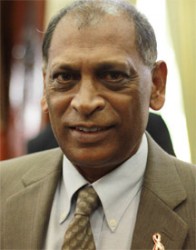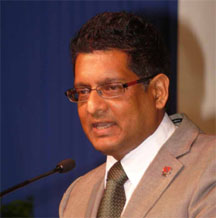While no investors have been identified as yet, Minister of Agriculture Dr Leslie Ramsammy and his Trinidadian counterpart Devant Maharaj are confident that Trinidadian farmers will be seizing the opportunity to utilise lands in Guyana for commodity farming.
The recently signed Memo-randum of Understanding between the two countries sets aside 10,000 acres of land here to be used


by Trinidadian farmers in the near future, while an additional 90,000 acres would also be made available depending on the success of the first 10,000.
Maharaj and Ramsammy met media practitioners at the Agriculture Ministry yesterday to discuss the current state of the agreement.
It was revealed that although a technical team was brought to Guyana and another team from Guyana will meet in Trinidad next Friday no concrete plans have yet been made. Maharaj stated that in two weeks’ time the land to be utilised will have been identified.
However, both Maharaj and Ramsammy also stated that the land location and allocation will be dependent on investors and their proposals.
Neither Ramsammy nor his counterpart made reference to Herstelling or the Mahaica-Berbice areas which teams had visited numerous times in the past year as potential locations for development.
Maharaj stated that “we are hopeful that the agro-entrepreneurs in Trinidad will seize the opportunity,” continuing that negotiations were still underway to identify the standardisation policies that would be followed by both countries. He did state that currently in Trinidad investors were being turned away so he was eager to get the ball rolling on the development of the 10,000 acres in Guyana.
“I am very confident and hopeful that it will be very well patronised because right now we are turning away investors because we do not have the lands available,” Maharaj said.
Neither minister answered direct questions on the findings of the technical teams. Maharaj stated that the technical team was brought in to encourage “transparency”.
He said no costs had been determined as yet highlighting that Guyana and T&T were only acting the capacity of facilitators.
Maharaj said Trinidad would advertise for expressions of interest in the coming weeks and once investors responded site visits would be arranged and proposals solicited. At which point both Guyana and Trinidad would be involved in the process of evaluating proposals. No timeframe was given any of this.
Maharaj stated that thus far corn and soya were being looked at to assist with the production of animal feed and tied to that was meat production from small ruminants. He continued that in particular root crops such as cassava would also be grown as well as legumes. Maharaj said aquaculture would also expand and all of the ventures would be based on reducing Trinidad’s current food bill. Currently there are two large-scale Trinidadian-owned farming operations in Guyana growing citrus and cassava.
Maharaj said that since these six commodities were identified, advertising would be thus tailored. He added that this initiative would not in any way stifle small-scale farmers and instead noted that this was an opportunity to create contract farming.
Maharaj noted that Guyana’s lands were being used to fill a gap that has long existed in Trinidad and Tobago since viable commercial lands are increasingly not available there. He brushed off criticism that his country does have uncultivated land that is currently under no cultivation stating that much of those lands are privately owned.
He did also state that what Guyana offers is the ability to cultivate large areas as opposed to in Trinidad where land was available but not for large-scale farming.
Meanwhile, Ramsammy stated that Guyana has a potential three million hectares that could be used for farming that could benefit the Caribbean region as a whole. He emphasised that the MOU was a prosperous initiative for both Guyana and Trinidad.





